How to Get Hair Dye Off Your Countertops in 4 Ways
Author: Anne Cowart | Editor: Omar Alonso
Review & Research: Jen Worst & Chris Miller
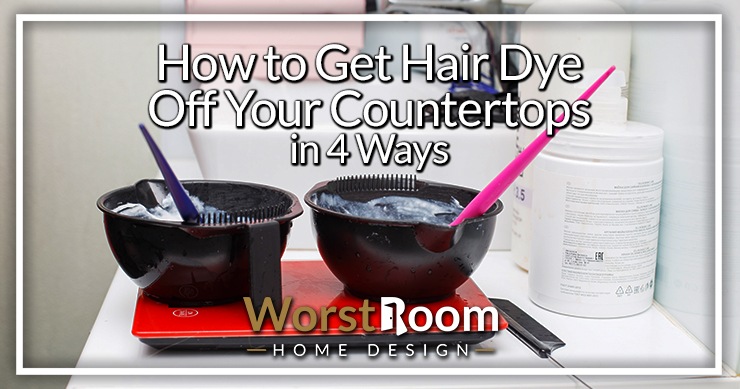
Dying your hair at home can be an excellent alternative to heading to the salon. It can save you time and money; plus, it’s fun to experiment with different colors. But first learn how to get hair dye off counter surfaces, because a stain is bound to happen.
But if you’re not extremely careful, you can easily spill drips of dye on your countertops, leaving them with unsightly stains. Even when you wipe them off quickly, they still leave behind a dark mark of color. There are several ways to remove stains like these—so don’t worry.
What Kind of Counters Can Hair Dye Stain?
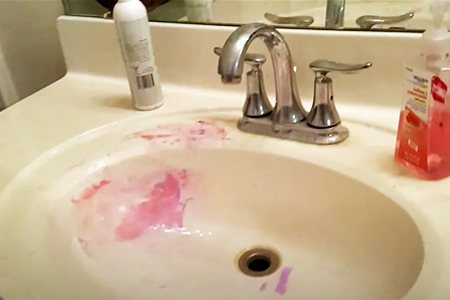
It’s not uncommon for hair dye to stain virtually any kind of countertop. After all, the substance is dying in nature; its goal is to leave lasting color.
But not all countertop materials are the same, and some take on stains more easily than others. A few stain-prone materials include:
- Plastic laminate
- Concrete
- Marble
- Wood
- Natural stone
- Granite
We've shared how to get hair dye off wood, if that's your specific scenario. That being said, even stain-resistant materials like quartz and solid-surface countertops can succumb to stains—especially those from home hair dye kits. The best way to prevent stains from happening is to cover and protect your counters before starting the process.
How To Remove Hair Dye From Countertops
Wiping and scrubbing a hair dye spot on your counter may prove to be a fruitless endeavor, but there are plenty of tricks and methods you can try to get that stain out. Below are some of our favorite hair dye removal solutions. Each is an answer for how to get hair dye off counter surfaces but you may need to try several to fully remove the stain, with it getting better with each attempt.
Acetone
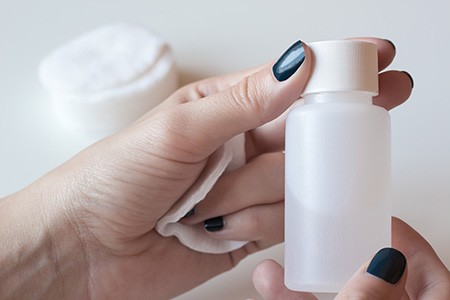
Acetone is a great liquid solvent that does a thorough job of breaking down and dissolving other substances. You’re probably most familiar with this product in the form of nail polish remover. But, just as acetone can break down nail polish, it can also work well on tough stains.
To use acetone to remove hair dye stains from your counter, gather the following:
- Water
- Cotton cloth
- Absorbent pads
- Acetone
Use an absorbent pad to soak up some acetone. Rub the pad over the stain, then place it on top of the mark and let it sit for about five minutes to let the alcohol do its job.
After the five minutes are up, rub the pad over the stain some more to remove the spot. If some of the stain remains, you can repeat this process.
Moisten the cotton cloth with some water and wipe over the spot on the counter to clean off the remaining acetone.
Acetone is also efficient at removing paint, so don’t use this method on any countertops treated with paints or stains. Instead, you can use acetone in the form of nail polish remover. Just ventilate so your house doesn't stink like acetone after.
Baking Soda & Vinegar
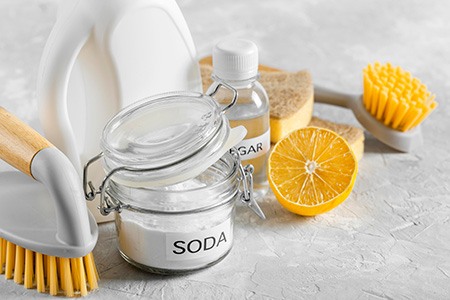
Baking soda and vinegar are words you often hear in a wide range of home cleaning tactics. That’s because both baking soda and vinegar and powerful cleansers. They’re also both common household products, so they’re super convenient to grab in a cleaning emergency.
One of the greatest parts about using baking soda and vinegar to clean is that these products are safe on most surfaces—even wood. So, whether you’re cleaning laminate or a wooden counter, you can try this method.
Grab the following items:
- Baking soda
- Vinegar
- Water
- Bowl
- Washcloth
Mix equal parts of the baking soda and vinegar. Be careful—adding vinegar to baking soda will cause a chemical reaction, making the mixture foam. Be sure your bowl is big enough to prevent it from overflowing.
Combine these two ingredients until you form a paste. Use the cloth to apply this paste to the hair dye stains on your counter. Rub gently until the stains come out. For tougher stains, let the paste sit for a few minutes before rubbing.
Use a clean cloth with warm water to clean up the paste once you’ve removed the stain. And that's how to remove hair dye from bathroom counters. If this only takes you so far, proceed to the next options to keep reducing the discoloration of the stain.
Bleach

Bleach is a prevalent and effective cleaner, but many people are starting to stray away from using it due to its potential risks—especially for pets and children.
While bleach does a thorough job of disinfecting and whitening, it poses a risk to people and animals. So be sure you know how to safely use bleach before attempting to remove stains with it, and that you know how to dispose of bleach safely.
Bleach is a potent stain killer and can get you out of a sticky hair dye situation when used properly. Here’s what you’ll need:
- Bleach
- Water
- Spray bottle
- Sponge
Always dilute your bleach when using it to clean home surfaces. The most common ratio is one to ten bleach to water. Add one part bleach to a spray bottle, then ten parts water. Gently shake to combine.
Spray the bleach solution on the stain and let it sit for five minutes. Using the sponge, scrub the spot after five minutes are up until the stain has lifted.
In some cases, you may need stronger bleach. This may be true if a hair dye stain has been on your counter for a long time. If the one-to-ten ratio doesn’t work, try a one-to-one ratio of bleach and water. Be sure to do so only in well-ventilated areas. You can try mixing bleach and baking soda as well.
Hydrogen Peroxide
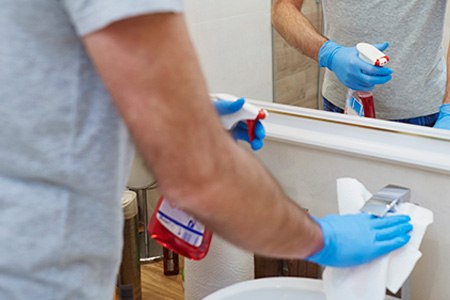
Hydrogen peroxide is another chemical that, like acetone, can be highly effective in removing stains. It’s also another common household item, as its multi-purpose makeup allows it to treat minor injuries, relieve mouth irritation, and clean surfaces.
Hydrogen peroxide is easy to use on countertop stains as well as for removing lipstick carpet stains. All you need is the following:
- Hydrogen peroxide
- Sponge
You don’t need to dilute hydrogen peroxide to use it on a countertop stain. Simply apply enough to cover the spot and let it sit for a few minutes to break down the dye. Then, take your sponge and use the rough side to scrub out the mark.
Rinse the sponge with warm water and use it to wipe the surface clean when you have finished removing the stain.
How to Prevent Countertop Hair Dye Stains
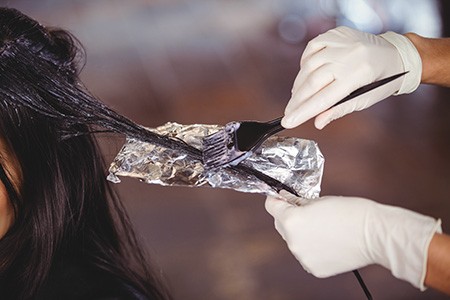
Knowing how to remove a hair dye stain from your counter is vital in case of accidents, but prevention can help you avoid the situation altogether. And now that your stain is gone, learn how to get hair out of carpet so you can return the original luster back to your rug.
Cover the Counter
Much like painting, it’s a good idea to cover the surface of your counter before you start the dying process. You can use things like old towels or plastic sheets to protect the counter. If something spills or drips, these coverings will catch it.
Wear Rubber Gloves
Most home hair dye kits come with rubber or plastic gloves; be sure to use them.
Not only will rubber gloves protect your hands from getting stained, but they make cleanup much easier and less messy. When you’re done dying your hair, take the gloves off by pulling from the wrist and turning them inside out. Then, toss them in the trash.
By doing this, you avoid the need to wash the hair dye from your hands in the sink and minimize the risk of dripping dye everywhere. You’re then free to clean up the rest of the bathroom with clean hands.
Ask for Help
If you’re new to home hair dying, consider asking a friend or family member for help. The less experience you have, the more likely you are to make a mess. A helping hand can keep your bathroom safer from spills.
That’s How to Get Hair Dye Off Counter Surfaces
Dying your hair at home can be a fun and inexpensive way to change up your look or keep up with incoming gray roots. While salon professionals know the best way to handle hair dye, it’s not hard to do it at home.
But dying your hair at home comes with the risk of spilling the product and leaving stains on your counters. Even the smallest drop of hair dye can leave a mark; it only takes a few seconds for the stain to set in.
Thankfully, these methods tell you how to get hair dye off counter surfaces in your home. However, be sure to take caution and consider testing these methods on small, hidden parts of your countertops first to avoid damaging them in plain sight. Next time you dye your hair, ensure that some of these products are within reach to attack stains quickly and effectively.




